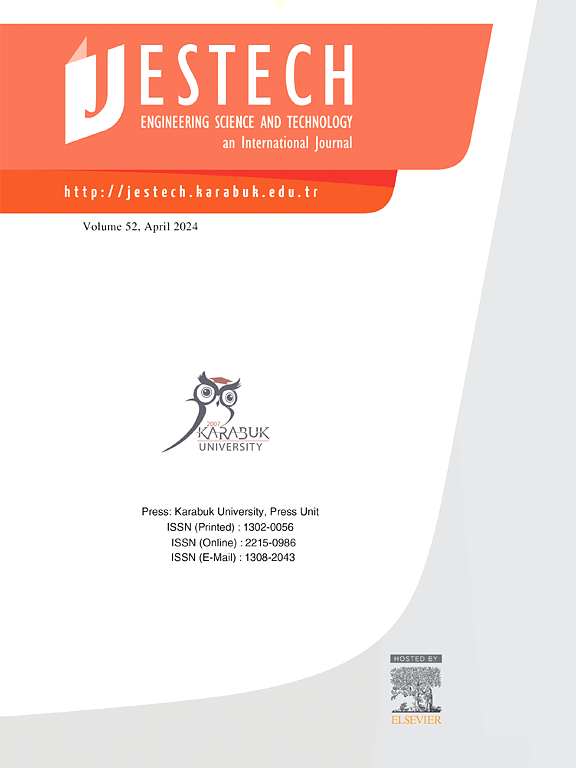Investigating the effects of Gaussian noise on epileptic seizure detection: The role of spectral flatness, bandwidth, and entropy
IF 5.1
2区 工程技术
Q1 ENGINEERING, MULTIDISCIPLINARY
Engineering Science and Technology-An International Journal-Jestech
Pub Date : 2025-02-21
DOI:10.1016/j.jestch.2025.102005
引用次数: 0
Abstract
This study investigates the effect of Gaussian noise on the classification of EEG signals from five classes in the Bonn University EEG dataset for epileptic seizure detection, using Power Spectral Density features. The EEG data are pre-processed with a low-pass filter at a cutoff frequency of 40 Hz, and a total of 11 features, including spectral flatness difference, spectral bandwidth difference, and entropy difference, are extracted. Feature vectors are generated for both original signals and signals with varying levels of injected Gaussian noise. The results demonstrate that noise injections significantly improve classification accuracy across all class combinations by enhancing feature separability and generalization. Notably, 100 % accuracy was achieved in classifications with different noise levels. Analyses performed using classifiers such as Random Forest, Multilayer Perceptron, and k-Nearest Neighbors show that the Random Forest classifier achieves high classification success across all noise levels. Additionally, it was found that incorporating spectral flatness difference, spectral bandwidth difference, and entropy difference features significantly contributes to classification accuracy when combined with noise injection. This study highlights the potential of noise injections to reduce overfitting and enhance the robustness of EEG classification, providing valuable insights for future biomedical signal analysis. Noise injection, traditionally viewed as a factor that could hinder performance, is utilized in this study as a novel approach to enhance classification accuracy, marking a significant innovation in the field.

求助全文
约1分钟内获得全文
求助全文
来源期刊

Engineering Science and Technology-An International Journal-Jestech
Materials Science-Electronic, Optical and Magnetic Materials
CiteScore
11.20
自引率
3.50%
发文量
153
审稿时长
22 days
期刊介绍:
Engineering Science and Technology, an International Journal (JESTECH) (formerly Technology), a peer-reviewed quarterly engineering journal, publishes both theoretical and experimental high quality papers of permanent interest, not previously published in journals, in the field of engineering and applied science which aims to promote the theory and practice of technology and engineering. In addition to peer-reviewed original research papers, the Editorial Board welcomes original research reports, state-of-the-art reviews and communications in the broadly defined field of engineering science and technology.
The scope of JESTECH includes a wide spectrum of subjects including:
-Electrical/Electronics and Computer Engineering (Biomedical Engineering and Instrumentation; Coding, Cryptography, and Information Protection; Communications, Networks, Mobile Computing and Distributed Systems; Compilers and Operating Systems; Computer Architecture, Parallel Processing, and Dependability; Computer Vision and Robotics; Control Theory; Electromagnetic Waves, Microwave Techniques and Antennas; Embedded Systems; Integrated Circuits, VLSI Design, Testing, and CAD; Microelectromechanical Systems; Microelectronics, and Electronic Devices and Circuits; Power, Energy and Energy Conversion Systems; Signal, Image, and Speech Processing)
-Mechanical and Civil Engineering (Automotive Technologies; Biomechanics; Construction Materials; Design and Manufacturing; Dynamics and Control; Energy Generation, Utilization, Conversion, and Storage; Fluid Mechanics and Hydraulics; Heat and Mass Transfer; Micro-Nano Sciences; Renewable and Sustainable Energy Technologies; Robotics and Mechatronics; Solid Mechanics and Structure; Thermal Sciences)
-Metallurgical and Materials Engineering (Advanced Materials Science; Biomaterials; Ceramic and Inorgnanic Materials; Electronic-Magnetic Materials; Energy and Environment; Materials Characterizastion; Metallurgy; Polymers and Nanocomposites)
 求助内容:
求助内容: 应助结果提醒方式:
应助结果提醒方式:


